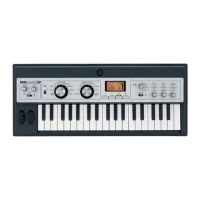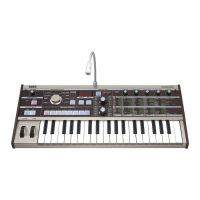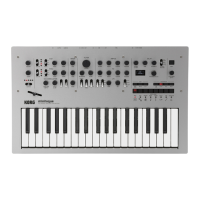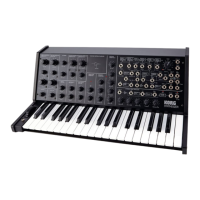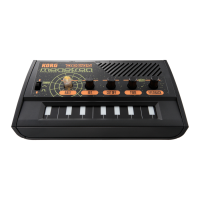Do you have a question about the Korg microX and is the answer not in the manual?
| Type | Synthesizer |
|---|---|
| Polyphony | 64 voices |
| Sound Engine/Synthesis Type | HI (Hyper Integrated) synthesis |
| Multitimbral | 16 parts |
| Oscillators | 2 per voice |
| Velocity Sensitivity | Yes |
| Aftertouch | No |
| Arpeggiator | Yes |
| Filters | Multi-mode (Lowpass, Highpass, Bandpass, Band Reject) |
| LFO | 2 LFOs |
| Keyboard | 37 keys |
| Controllers | Joystick |
| Inputs | 1 x Audio IN |
| Outputs | 2 x 1/4" (L/Mono, R) |
| MIDI | In, Out, Thru |
| USB | USB MIDI |
| Power Supply | 9V DC |
| Weight | 2 kg |
Initial steps for connecting the microX and audio equipment.
Guide to selecting and playing sounds.
Procedures for safely powering the unit on and off.
Diagram and explanation for audio output connections.
Methods for connecting the microX to a computer via USB or MIDI.
Methods for selecting and playing sounds.
Making basic sound adjustments using front panel controls.
Adjusting tone using filter types, cutoff, and resonance.
Methods for selecting and playing sounds.
Making basic sound adjustments within a Combination.
Using keyboard zones and velocity to switch between Timbres.
How oscillator outputs are routed to effects.
Steps to select and configure insert effects.
Basic system settings including tuning and velocity curves.
Globally disabling insert and master effects.
Configuring global MIDI channel and filter settings.
Using the arpeggiator in Program mode.
Controlling arpeggiator functions with front panel controls.
Saving edited arpeggiator settings.
Editing dual arpeggiators in Combination and Multi modes.
Procedures for saving edited user arpeggio patterns.
Procedures for saving edited drum kit data.
Procedures for saving edited external control setups.
Methods for saving various types of data.




